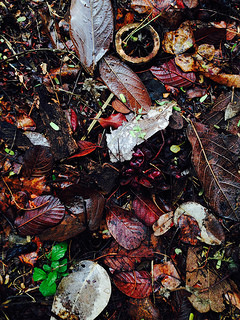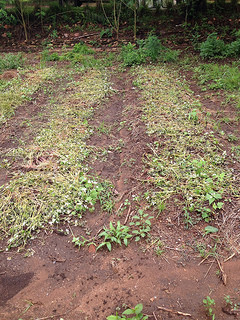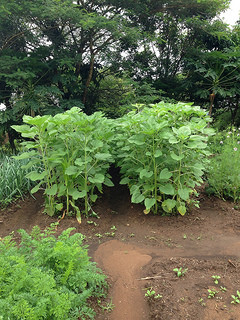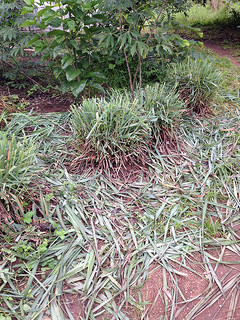One of the most rewarding things to do here at Kusamala is determining what mulch-producing plants can be incorporated into the landscape of the Residential Garden. Making space for mulch-producing plants localizes resources onsite and creates a sustainable system for establishing biomass.

Worm food (almost): Protein-rich nitrogen fixing leguminous foliage mixes with broadleaf debris on the forest floor.
Mulching mimics the natural process of decomposition that happens both above and below the forest floor. When we observe the interaction of the components within these horizons, we see a dry layer of leaves from both nitrogen fixing and broad-leaf trees as well as other organic plant debris, in a whole state or starting to break down. Underneath is another layer of the same litter crumbled and almost unrecognizable from its parent material.
A little deeper down we come to the forest floor. There’s a mushy combination of dark substances here that have decomposed significantly. We might see some evidence of worms by observing their crumbled castings. Just underneath this surface we find their tunnels reinforced by their own mucosal secretions. These tunnels allow water and air to pass through while creating a stable soil structure.
If we were to use a microscope, we could see tiny bacteria dancing around root zones or being chased by huge blob-like things that whirl them into their mouths. Tubular nematodes flit by in search of bacteria or fungi. Huge mats of Mycorrhizal fungi are feeding the system, trans-locating nutrients to connected plants. There is a tiny ecosystem or world occurring, that is, at its simplest, turning the environment into a fertile one.
That’s the big idea when I’m selecting plants to build garden soil through mulching. I prefer this method of mulching because it can closely mimic the natural cycle that environments go through. I’ve been researching and experimenting with a variety of plants and plant combinations that can serve multiple functions in a small garden but that are ideally intended to provide mulch in the form of accumulated biomass after leaf drop or through seasonal slashing. As a secondary beneficial attribute, I’m also interested in those plants that possess root systems capable of improving soil structure, that can return leached nutrients back to the surface, and that can turn inhospitably hot soils into temperate zones suitable for the biological functions necessary for a healthy soil ecology.
So far my favorite combination of plants to achieve this system is a multiple tiered grouping consisting of Pigeon Pea, Sunflower, Tithonia, Lemon Grass, Comfrey and Cowpea. This guild offers support for climbing plants, places to perch for birds, a habitat for beneficial insects all while a patient farmer can intersperse vegetable crops where space allows. While other plants should also be considered when trying to establish a system of soil-improvers, it’s important to consider those plants that can build layers of organic matter rather than having to import it from other zones or an offsite source.
Stay tuned for more of my musings on mulching materials in the blogs to come. Thanks!




